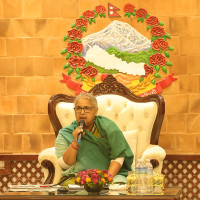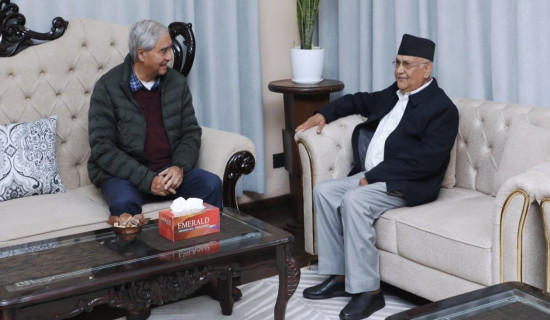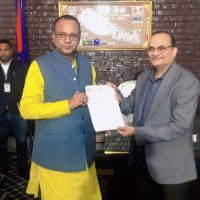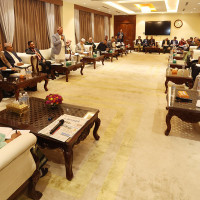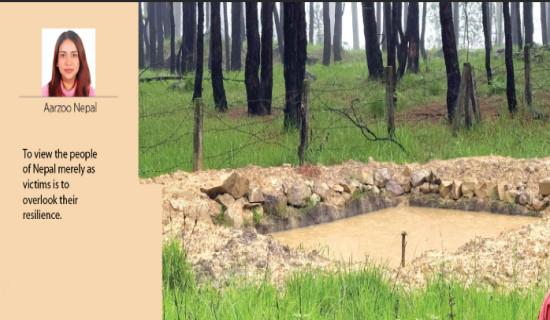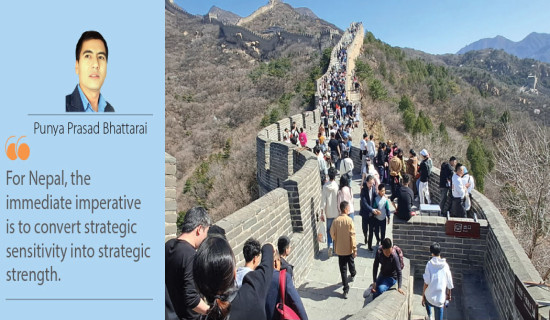- Saturday, 6 December 2025
National Art Exhibition Celebrates Diversity
The National Fine Art Exhibition 2082 at the Nepal Academy of Fine Arts celebrated creativity, diversity, and unity. Right from the moment visitors entered the academy complex, a beautiful sculpture, Mahish Shamvar, greeted them. The more-than-eight-foot-tall structure, created by artist Kalu Kumale, had immense symbolic meaning. It was tantric in philosophy, and every limb and detail told of feeling and mystery. It immediately set the tone for a journey into Nepal's artistic mind.
At the academy, the exhibition had taken up six galleries, bringing together more than 600 artists from all seven provinces. The exhibition displayed a wide range of art forms—traditional paintings, folk paintings, sculptures, digital art, photography, and handicrafts. Combining artists and art forms under one roof made it a lively and colourful event. It was a visual and emotional echo of our country's rich cultural diversity.
The tour began in the Chandraman Singh Gallery, where paintings from the Madhes and Sudurpashchim provinces were displayed. On the Madhe's side, there was the influence of Mithila art. The paintings reflected local life, the role of women, festivals, and mythological tales like Ram and Sita. Mithila art, which women initially created, has now become a shared tradition between men and women. Bright primary colours—red, yellow, green, and blue—made the artwork stand out. They portrayed happiness, daily life, and the symbolic beauty of the Madhes community.
In the Sudurpashchim segment, art conveyed a mix of modernity and tradition of thought. While a few artists painted abstract figures, others were busy with social messages. Despite new styles and forms, the connection to the region's cultural heritage was not severed. Themes like folk culture, landscapes, and festivals were painted in artworks and sculptures. It was clear that Sudurpashchim artists were experimenting with new ideas without forgetting where they belonged.
At the centre of the academy courtyard stood the official emblem of the exhibition. It was a creative design of seven leaves growing and encircling each other at the top. Each leaf represented one of the country's seven provinces. The circle signified harmony and unity in federal Nepal. The emblem was a symbol for the exhibition. It was a lasting decoration that adorned the academy premises even after the exhibition.
One of the highlights of this year's show was the participation of the Raute community from Karnali Province. It was the nomadic Raute people's first involvement in a national art activity. The Rautes stayed at the academy for three days, producing wood carvings and handmade products. Their works were raw, intense, and full of untold stories. It was a moment of pride and inclusion for the exhibition.
Other artists from Karnali also presented paintings that portrayed the region's natural beauty and human life. Karnali's slow but steady progress in contemporary art was visible and meaningful.
Gandaki Province presented a new and modern vision at the exhibition. Artists from this province used new methods like abstract painting, digital media, and mixed media. Some young artists also created impactful cartoons. However, traditional forms like watercolour and classical style were also displayed, reminding everyone that Gandaki values novelty and tradition. In the coming years, the province must maintain this balance between the new and old.
One of the largest and most diverse collections was held by Bagmati Province. Some highlights were classical Newar and Tamang art, including thangka and paubha paintings. They most often depicted Buddhist and Hindu myths, symbols, and themes of meditation, divine energy, and cosmic harmony. These were complemented by works of modern artists that touched upon contemporary issues of gender violence, global warming, and mental health. Bagmati Province once more proved to be the centre of Nepal's traditional and modern art world.
Koshi Province of eastern Nepal presented a gentle and balanced creative expression. The paintings expressed harmony between the hills and plains, human beings and nature. The colours were subtle yet strong. Artists painted everyday life, cultural festivals, and harmony between human beings and their environment. The emotional depth of the artworks left a lasting effect on the spectators.
At the other extreme of the exhibition stood the Lumbini Gallery. Here, the focus was on Awadhi art, which is now gaining popularity. While Mithila art has already won global recognition, Awadhi art is also beginning to take shape. Some of the paintings from this area even received awards. The life and teachings of the Buddha inspired several of the paintings. Artists from Lumbini also experiment with contemporary styles, but the region must still strive to promote and conserve its indigenous art forms.
The exhibition was a stroll through story, strife, faith, and cultural identity. Viewers were invited to identify with each province's own life and experience. The national activity became a shared space for storytelling through colour, form, and texture.
The exhibition was enriching in numerous ways. It united various artists nationwide, offering room for traditional and modern art. Workshops allowed the audience to get directly involved with the process of creation. Most importantly, the paintings displayed had been chosen after being showcased in the provinces. This helped ensure that there would be something from every region and honoured the federal spirit of Nepal.
Yet, there were some areas for improvement. With limited space and infrastructure, some artworks were not presented appropriately. Proper viewing distance was hard to achieve, detracting from the appreciation of some pieces. Not all the galleries provided clear information or explanations, making the work more challenging for viewers. Including more established artists and being more selective with higher-quality contemporary works would enhance the overall level. Folk and handicraft pieces contributed to the charm, but modern art must be more carefully curated to prevent clutter.
Despite these concerns, the show proved that Nepal's art is breathing, growing, and connected to the people. This year's show was more varied and organised than in the past. The show got good public attention, with attendance of more than 30,000 visitors. The Nepal Academy of Fine Arts must maintain this momentum in the coming years, attract more audiences, and further boost the show's quality.
(The author is an art manager at Gorkhapatra Corporation.)




